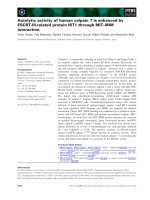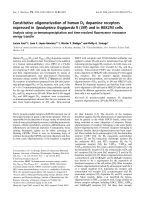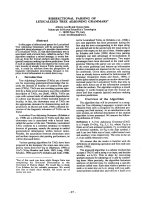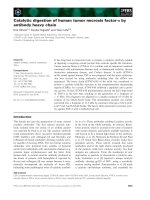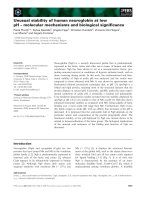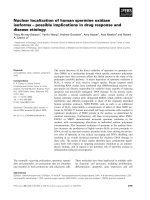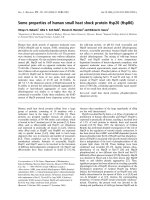Báo cáo khoa học: "Atypical presentation of angiosarcoma of the scalp in the setting of Human Immunodeficiency Virus (HIV)" pdf
Bạn đang xem bản rút gọn của tài liệu. Xem và tải ngay bản đầy đủ của tài liệu tại đây (527.71 KB, 4 trang )
BioMed Central
Page 1 of 4
(page number not for citation purposes)
World Journal of Surgical Oncology
Open Access
Case report
Atypical presentation of angiosarcoma of the scalp in the setting of
Human Immunodeficiency Virus (HIV)
Poovandren S Govender
Address: Department of Radiotherapy and Oncology, Nelson R. Mandela School of Medicine, University of Kwazulu Natal, Durban, South Africa
Email: Poovandren S Govender -
Abstract
Background: Angiosarcoma of the head and neck is an uncommon, aggressive malignant entity
most commonly found in elderly Caucasian males. We present a case in a young black female with
co-existing HIV. The atypical gender, age and race of the patient reflect the unusual clinical
presentation of this case of angiosarcoma, attributable to the patient's HIV status.
Case presentation: A 22 year old patient presented with a large unresectable lesion over the
occiput with surrounding ulceration, satellite lesions and associated lymphadenopathy. She is HIV-
infected with a CD4 count of 360 cells/μl. She was not on antiretroviral treatment based on South
African treatment guidelines advocating antiretroviral treatment when the CD4 count is below 200
cells/μl, in the absence of other AIDS-defining illnesses.
The patient was treated with a course of ifosfamide and anthracyline based chemotherapy. Disease
progression was noted on chemotherapy and she was subsequently palliated with a course of
radiotherapy. She had a satisfactory response with an improvement in local symptoms. She is
currently receiving symptomatic care.
Conclusions: South Africa is at the epicenter of the HIV epidemic. Consequently, the management
of patients in the field of oncology in our clinical practice is often burdened with malignancies
manifesting with an atypical disease presentation and clinical course.
Background
Angiosarcoma of the head and neck is an uncommon
aggressive cancer of the skin and soft tissues [1]. These
malignancies are most commonly found in Caucasians
and are 3-4 times more common in males than females
with a median age of 61 to 67 years [2,3].
We report an atypical presentation of a case of angiosar-
coma of the scalp occurring in association with HIV in a
22 year old black female.
Linkage studies of population-based registries involving
people with HIV/AIDS and cancer have shown a statisti-
cally significant increase in the incidence and relative risk
of many Non-AIDS Defining Cancers (NADCs). Tumours
displaying unusual features and aggressive behaviour pat-
terns in young individuals should alert physicians to the
possibility of underlying HIV infection [4].
HIV-related defects in the cell mediated immunity lead to
an increased risk of malignancy due to decreased tumour
surveillance and suppression of oncogenic viruses. How-
ever, the role of immunosuppression in the pathogenesis
of NADC is controversial, based on studies demonstrating
that the increased risk of NADC is not associated with low
CD4 T-lymphocyte cell counts or the onset of AIDS [4].
Published: 18 December 2009
World Journal of Surgical Oncology 2009, 7:99 doi:10.1186/1477-7819-7-99
Received: 31 October 2009
Accepted: 18 December 2009
This article is available from: />© 2009 Govender; licensee BioMed Central Ltd.
This is an Open Access article distributed under the terms of the Creative Commons Attribution License ( />),
which permits unrestricted use, distribution, and reproduction in any medium, provided the original work is properly cited.
World Journal of Surgical Oncology 2009, 7:99 />Page 2 of 4
(page number not for citation purposes)
The impact of HIV on the South African healthcare system
has been profound. The total number of persons living
with HIV in South Africa increased from an estimated 4.1
million in 2001 to 5.2 million by 2009. For 2009, an esti-
mated 10.6% of the total population is HIV positive [5].
The scourge of HIV in sub-Saharan Africa has contributed
to the unusual clinical presentation and natural history of
malignant disease.
Case presentation
A young black female presented with a 6 month history of
a mass over the posterior aspect of her scalp which was
initially thought to be an abscess and subsequently ulcer-
ated. There was no history of previous radiotherapy or
trauma to the scalp.
Clinically, she had a 12 cm by 10 cm diameter, ulcerative
lesion over the occiput with surrounding ulceration and
satellite lesions. Examination of the neck revealed bilat-
eral level II-V lymphadenopathy measuring approxi-
mately 1 cm in diameter (Figure 1).
Biopsy of the occipital scalp mass demonstrated an epi-
thelioid angiosarcoma. She also had a biopsy of a cervical
lymph node which demonstrated features of a metastatic
epithelioid angiosarcoma.
HIV Elisa was positive with a CD4 count of 360 cells/μl.
Computed Tomography (CT) scan revealed a large heter-
ogeneously enhancing soft tissue mass over the scalp in
the occipital region with erosion of the underlying bone.
Extensive subcentimetre enhancing lymphadenopathy
was noted in the anterior and posterior triangles of the
neck with the largest noted in the right parotid region
measuring 1.1 cm. No distant metastases were noted (Fig-
ure 2).
She was treated with chemotherapy (Epi-doxorubicin 40
mg/m
2
I.V d1-3, Ifosfamide 1.5 g/m
2
I.V d1-3, q 3/52).
Clinical disease progression was noted after 3 cycles of
chemotherapy (Figure 3).
We then opted to treat her palliatively with electron beam
radiotherapy. An irregular electron cut-out was used to
define the treatment area. A single posterior field of 15
MeV electrons was used to deliver the prescribed dose of
3000 cGy to the 80% isodose curve in 10 fractions (3 Gy/
fraction) over 2 weeks. She had a satisfactory response to
treatment with an improvement in local symptoms.
She was subsequently managed symptomatically.
Discussion
Sarcomas are uncommon in the head and neck region
constituting only 1% of all malignant neoplasms in this
region. Angiosarcomas make up less than 1 percent of all
sarcomas. Their most frequent site of origin is the head
and neck, especially the scalp of elderly men. These highly
aggressive mesenchymal tumours may arise in association
with some recognised clinical condition (chronic lym-
phoedema or previous irradiation) or as a de novo occur-
rence [6].
Cutaneous angiosarcoma of the head and neck is a dis-
tinct subtype which most commonly presents as an
enlarging purple bruise-like lesion that develops over sev-
eral months. There may be intermittent bleeding, oedema
or ulceration. A delay in diagnosis is common in the early
stages of disease due to confusion with infection, or trau-
matic bruises [7].
These malignancies spread radially within the dermis of
the scalp and face and are associated with ecchymotic
patches extending beyond the obvious lesion, making it
difficult to achieve excision with clear margins. It is often
multifocal and associated with a high incidence (10-15%)
of lymph node metastasis [2].
There is currently no accepted staging system for this dis-
ease [8].
There is also no standard treatment schedule for these
malignancies on account of its rarity. Surgery is consid-
ered the mainstay of treatment with wide local excision
and frozen section control. Prognosis correlates well with
the ability to attain clear surgical resection margins
although the tendency of scalp angiosarcoma to demon-
Initial presentationFigure 1
Initial presentation.
World Journal of Surgical Oncology 2009, 7:99 />Page 3 of 4
(page number not for citation purposes)
strate a diffuse pattern of clinically undetectable spread
makes resection challenging [9].
The role of radiotherapy is less well-defined. The reported
outcomes of radiotherapy alone have largely been unsat-
isfactory. Several authors have thus recommended a treat-
ment approach comprising both surgery and
radiotherapy. Wide field radiotherapy appears to be a
rational therapeutic choice for scalp angiosarcoma
because the involved dermis as well as a sufficient area of
surrounding skin can be treated, while sparing the brain
and other normal tissue [9].
Chemotherapy has been suggested for unresectable cases,
but has generally not proven beneficial [8]. Anthracy-
clines have been most commonly used in the past, either
as a single agent or as a component of combination ther-
apy [7]. Although no phase II trials were performed specif-
ically for angiosarcomas, doxorubicin and ifosfamide are
generally considered the most active chemotherapeutic
agents [10]. Liposomal doxorubicin and paclitaxel have
also demonstrated response in angiosarcomas [1-10].
The overall prognosis for angiosarcomas is poor when
compared to other head and neck sarcomas with the 5
year survival rate ranging from 4 to 20% [6]. Local recur-
rence and metastases are very frequent regardless of the
treatment modality employed [8].
Conclusion
South Africa is at the epicenter of the HIV epidemic. Con-
sequently, the management of patients with malignant
neoplasms in our context is often compounded by atypi-
cal disease presentation and clinical course. This case of
Enhancing mass lesion in occiput on axial and saggital CT slicesFigure 2
Enhancing mass lesion in occiput on axial and saggital CT slices.
Disease progression on chemotherapyFigure 3
Disease progression on chemotherapy.
Publish with BioMed Central and every
scientist can read your work free of charge
"BioMed Central will be the most significant development for
disseminating the results of biomedical research in our lifetime."
Sir Paul Nurse, Cancer Research UK
Your research papers will be:
available free of charge to the entire biomedical community
peer reviewed and published immediately upon acceptance
cited in PubMed and archived on PubMed Central
yours — you keep the copyright
Submit your manuscript here:
/>BioMedcentral
World Journal of Surgical Oncology 2009, 7:99 />Page 4 of 4
(page number not for citation purposes)
angiosarcoma of the scalp co-existing with HIV is indica-
tive of the challenges faced by the oncology fraternity in
our country.
Consent
Written informed consent was obtained from the patient
for publication of this case report and any accompanying
images. A copy of the written consent is available for
review by the Editor-in-Chief of this journal.
Competing interests
The author declares that they have no competing interests.
Authors' contributions
PSG participated in the treatment of the patient, collec-
tion of case details, literature search and drafted the man-
uscript. The author has read and approved the final
manuscript.
References
1. Holloway CL, Turner AR, Dundas GS: Cutaneous angiosarcoma
of the scalp: A case report of sustained complete response
following liposomal doxorubicin and radiation therapy. Sar-
coma 2005, 9(1/2):29-31.
2. Rajinikanth J, Gaikwad P, Raj JP, Tirkey AJ, Muthusami JC: Angiosar-
coma of the scalp. Otolaryngol-Head and Neck Surg 2008,
138:255-256.
3. Obeng MK, Hernandez A, Dastgir A, Adegboyega PA, Salinas P, Gore
DC: Angiosarcoma of the scalp with calvarium involvement
in a 50 year old African-American man. J Natl Med Assoc 2004,
96(11):1507-1512.
4. Pantanowitz L, Schlecht HP, Dezube BJ: The growing problems of
non-AIDS-defining malignancies in HIV. Curr Opin Oncol 2006,
18:469-478.
5. 'Mid-year population estimates 2009' [http://
www.statssa.gov.za/PublicationsHTML/P03022009/html/
P03022009.html]
6. Köhler HF, Neves RI, Brechtbühl ER, Granja NVM, Ikeda MK, Kowal-
ski LP: Cutaneous angiosarcoma of the head and neck: Report
of 23 cases from a single institution. Otolaryngol-Head and Neck
Surg 2008, 139:519-524.
7. Lankester KJ, Brown RSD, Spittle MF: Complete resolution of
angiosarcoma of the scalp with liposomal daunorubicin and
radiotherapy. Clin Oncol (R Coll Radiol) 1991, 11:208-210.
8. Fedok FG, Levin RJ, Maloney ME, Tipirneni K: Angiosarcoma: Cur-
rent Review. Am J Otolaryngol 1999, 20(4):223-231.
9. Ohguri T, Imada H, Nomoto S, Yahara K, Hisaoka M, Hashimoto H,
Tokura Y, Nakamura K, Shioyama Y, Honda H, Terashima H, Moroi
Y, Furue M, Korogi Y: Angiosarcoma of the scalp treated with
recombinant Interleukin-2 immunotherapy. Int J Radiat Oncol
Biol Phys 2005, 61(5):1446-1453.
10. Schlemmer M, Reichardt P, Verweij J, Hartmann JT, Judson I, Thyss A,
Hogendoorn PCW, Marreaud S, Van Glabbeke M, Blay JY: Paclitaxel
in patients with advanced angiosarcomas of soft tissue: A
retrospective study of the EORTC soft tissue and bone sar-
coma group. Eur J Cancer 2008, 44:2433-2436.
